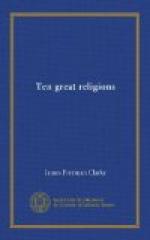[4] John Locke, in his “Reasonableness of Christianity,” says that when Christ came “men had given themselves up into the hands of their priests, to fill their heads with false notions of the Deity, and their worship with foolish rites, as they pleased; and what dread or craft once began, devotion soon made sacred, and religion immutable.” “In this state of darkness and ignorance of the true God, vice and superstition held the world.” Quotations of this sort might be indefinitely multiplied. See an article by the present writer, in the “Christian Examiner,” March, 1857.
[5] Mosheim’s Church History, Vol. I. Chap. I.
[6] Neander, Church History, Vol. I. p. 540 (Am. ed.).
[7] Essays and Reviews, Article VI.
[8] In this respect the type has changed.
[9] The actual depth reached in the St. Louis well, before the enterprise was abandoned, was 3,8431/2 feet on August 9, 1869. This well was bored for the use of the St. Louis County Insane Asylum, at the public expense. It was commenced March 31, 1866, under the direction of Mr. Charles H. Atkeson. At the depth of 1,222 feet the water became saltish, then sulphury. The temperature of the water, at the bottom of the well, was 105 deg.F. Toward the end of the work it seemed as if the limit of the strength of wood and iron had been reached. The poles often broke at points two or three thousand feet down. “Annual Report (1870) of the Superintendent of the St. Louis County Insane Asylum.”
[10] Andrew Wilson ("The Ever-Victorious Army, Blackwood, 1868”) says that “the Chinese people stand unsurpassed, and probably unequalled, in regard to the possession of freedom and self-government.” He denies that infanticide is common in China. “Indeed,” says he, “there is nothing a Chinaman dreads so much as to die childless. Every Chinaman desires to have as large a family as possible; and the labors of female children are very profitable.”
[11] Quoted by Mr. Meadows, who warrants the correctness of the account. “The Chinese and their Rebellions,” p. 404.
[12] Dr. Legge thus arranges the Sacred Books of China, or the Chinese Classics:—
A. The Five King. [King
means a web of cloth, or the warp which
keeps the threads in
their place.]
(a) Yih-King. (Changes.) (b) Shoo-King. (History.) (c) She-King. (Odes.) (d) Le-Ke-King. (Rites.) (e) Ch’un-Ts’eu. (Spring and Autumn. Annals from B.C. 721 to 480.)
B. The Four Books.
(a) Lun-Yu. (Analects,
or Table-Talk of Confucius.)
(b) Ta-Hio. (Great
Learning. Written by Tsang-Sin, a disciple
of
Confucius.)
(c) Chung-Yung (or
Doctrine of the Mean), ascribed to Kung-Keih,
the
grandson of Confucius.
(d) Works of Mencius.
After the death of Confucius there was a period in which the Sacred Books were much corrupted, down to the Han dynasty (B.C. 201 to A.D. 24), which collected, edited, and revised them: since which time they have been watched with the greatest care.




